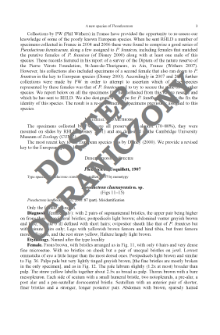
Obiekt
Tytuł: Current status of conservation and systematics in Korean flora: a case study of Eleutherococcus (Araliaceae)
Twórca:
Sun, Byung-Yun ; Chul, Hwan Kim ; Polska Akademia Nauk. Muzeum i Instytut Zoologii
Data wydania/powstania:
Typ zasobu:
Inny tytuł:
Fauna and Flora of the Korean Peninsula ; Ochrona i systematyka flory koreańskiej badania nad Eleutherococcus (Araliaceae) ; Conservation of Araliaceae in Korea
Wydawca:
Muzeum i Instutyt Zoologii Polskiej Akademii Nauk
Miejsce wydania:
Opis:
W serii gł.: Fragmenta Faunistica, t. 40, nr 22 ; Zawiera materiały z konferencji: Polish-Korean Joint Seminar Fauna and Flora of the Korean Peninsula: Their Inventory, Systematics and Evolution in Perspective of Biodiversity Conservation ; Bibliogr. p. 270 ; P. 265-271 ; 24 cm ; Abstract in Polish. Taxa in Latin.
Typ obiektu:
Abstrakt:
Korea is relatively small in size but the flora is very rich in species composition and has very close floristic relationships with China and Japan. According to the most recent comprehensive floristic work, 3 914 taxa of vascular plants which comprise 189 families and 1 044 genera are known to be distributed in Korea. Among them, 407 taxa which belongs to 339 species 46 varieties and 22 forms are generally recognized as endemic to Korea. In addition, six genera including Abeliophyllum (Oleaceae), Echinosophora (Fabaceae), Hanabusaya (Campanulaceae), Homopterix (Apiaceae), Megaleranthis (Ranunculaceae), and Pentactina (Rosaceae) are strictly confined to Korean peninsula. The naturalized plants in Korea comprises 181 taxa belonging to 33 families, 176 species, 3 varieties and 2 forms. Eleutherococcus is an Asian endemic genus with about 35 species worldwide mainly distributed in Eastern North Asia. In Korea, six species and one variety have been known to distribute, however, through this study, Korean Eleutherococcus can be rearranged into 4 species and two varieties which includes E. gracilistylus, E. divaricatus var. divaricatus, E. divaricatus var. chiisanensis, E. sessiliflorus, and E. senticosus.
Czasopismo/Seria/cykl:
Fragmenta Faunistica ; Fragmenta Faunistica. Fauna and Flora of the Korean Peninsula
Tom:
Zeszyt:
Strona pocz.:
Strona końc.:
Szczegółowy typ zasobu:
Format:
Identyfikator zasobu:
oai:rcin.org.pl:54436 ; 10.3161/00159301FF1997.40.22.265
Źródło:
MiIZ PAN, call no. P.256, T. 40 nr 22 ; MiIZ PAN, call no. P.4664, T. 40 nr 22 ; kliknij tutaj, żeby przejść
Język:
Prawa:
Rights Reserved - Restricted Access
Zasady wykorzystania:
Digitalizacja:
Museum and Institute of Zoology of the Polish Academy of Sciences
Lokalizacja oryginału:
Library of the Museum and Institute of Zoology of the Polish Academy of Sciences
Dofinansowane ze środków:
Programme Innovative Economy, 2010-2014, Priority Axis 2. R&D infrastructure ; European Union. European Regional Development Fund
Dostęp:
Kolekcje, do których przypisany jest obiekt:
- Repozytorium Cyfrowe Instytutów Naukowych > Kolekcje Partnerów > Muzeum i Instytut Zoologii PAN > Czasopisma
- Repozytorium Cyfrowe Instytutów Naukowych > Kolekcje Partnerów > Muzeum i Instytut Zoologii PAN > Wydawnictwa MiIZ PAN > Fragmenta Faunistica
- Repozytorium Cyfrowe Instytutów Naukowych > Piśmiennictwo > Czasopisma/Artykuły
Data ostatniej modyfikacji:
6 lis 2023
Data dodania obiektu:
22 cze 2015
Liczba pobrań / odtworzeń:
68
Wszystkie dostępne wersje tego obiektu:
https://rcin.org.pl./publication/60924
Wyświetl opis w formacie RDF:
Wyświetl opis w formacie RDFa:
Wyświetl opis w formacie OAI-PMH:
Obiekty Podobne
Trojan, Przemysław Wytwer, Jolanta Polska Akademia Nauk. Muzeum i Instytut Zoologii
Szeptycki, Andrzej (1939–2008) Polska Akademia Nauk. Muzeum i Instytut Zoologii
Kim, Yong-Shik Lee, Yoo-Mi Polska Akademia Nauk. Muzeum i Instytut Zoologii
Kwon, Yong Jung Huh, Eun Yeop Polska Akademia Nauk. Muzeum i Instytut Zoologii
Koh, Hung Sun Polska Akademia Nauk. Muzeum i Instytut Zoologii
Pawłowski, Jerzy Tomek, Teresa Polska Akademia Nauk. Muzeum i Instytut Zoologii.
Kim, Won (1955– ) Polska Akademia Nauk. Muzeum i Instytut Zoologii
Tomek, Teresa (1945– ) Polska Akademia Nauk. Muzeum i Instytut Zoologii

 INSTYTUT ARCHEOLOGII I ETNOLOGII POLSKIEJ AKADEMII NAUK
INSTYTUT ARCHEOLOGII I ETNOLOGII POLSKIEJ AKADEMII NAUK
 INSTYTUT BADAŃ LITERACKICH POLSKIEJ AKADEMII NAUK
INSTYTUT BADAŃ LITERACKICH POLSKIEJ AKADEMII NAUK
 INSTYTUT BADAWCZY LEŚNICTWA
INSTYTUT BADAWCZY LEŚNICTWA
 INSTYTUT BIOLOGII DOŚWIADCZALNEJ IM. MARCELEGO NENCKIEGO POLSKIEJ AKADEMII NAUK
INSTYTUT BIOLOGII DOŚWIADCZALNEJ IM. MARCELEGO NENCKIEGO POLSKIEJ AKADEMII NAUK
 INSTYTUT BIOLOGII SSAKÓW POLSKIEJ AKADEMII NAUK
INSTYTUT BIOLOGII SSAKÓW POLSKIEJ AKADEMII NAUK
 INSTYTUT CHEMII FIZYCZNEJ PAN
INSTYTUT CHEMII FIZYCZNEJ PAN
 INSTYTUT CHEMII ORGANICZNEJ PAN
INSTYTUT CHEMII ORGANICZNEJ PAN
 INSTYTUT FILOZOFII I SOCJOLOGII PAN
INSTYTUT FILOZOFII I SOCJOLOGII PAN
 INSTYTUT GEOGRAFII I PRZESTRZENNEGO ZAGOSPODAROWANIA PAN
INSTYTUT GEOGRAFII I PRZESTRZENNEGO ZAGOSPODAROWANIA PAN
 INSTYTUT HISTORII im. TADEUSZA MANTEUFFLA POLSKIEJ AKADEMII NAUK
INSTYTUT HISTORII im. TADEUSZA MANTEUFFLA POLSKIEJ AKADEMII NAUK
 INSTYTUT JĘZYKA POLSKIEGO POLSKIEJ AKADEMII NAUK
INSTYTUT JĘZYKA POLSKIEGO POLSKIEJ AKADEMII NAUK
 INSTYTUT MATEMATYCZNY PAN
INSTYTUT MATEMATYCZNY PAN
 INSTYTUT MEDYCYNY DOŚWIADCZALNEJ I KLINICZNEJ IM.MIROSŁAWA MOSSAKOWSKIEGO POLSKIEJ AKADEMII NAUK
INSTYTUT MEDYCYNY DOŚWIADCZALNEJ I KLINICZNEJ IM.MIROSŁAWA MOSSAKOWSKIEGO POLSKIEJ AKADEMII NAUK
 INSTYTUT PODSTAWOWYCH PROBLEMÓW TECHNIKI PAN
INSTYTUT PODSTAWOWYCH PROBLEMÓW TECHNIKI PAN
 INSTYTUT SLAWISTYKI PAN
INSTYTUT SLAWISTYKI PAN
 SIEĆ BADAWCZA ŁUKASIEWICZ - INSTYTUT TECHNOLOGII MATERIAŁÓW ELEKTRONICZNYCH
SIEĆ BADAWCZA ŁUKASIEWICZ - INSTYTUT TECHNOLOGII MATERIAŁÓW ELEKTRONICZNYCH
 MUZEUM I INSTYTUT ZOOLOGII POLSKIEJ AKADEMII NAUK
MUZEUM I INSTYTUT ZOOLOGII POLSKIEJ AKADEMII NAUK
 INSTYTUT BADAŃ SYSTEMOWYCH PAN
INSTYTUT BADAŃ SYSTEMOWYCH PAN
 INSTYTUT BOTANIKI IM. WŁADYSŁAWA SZAFERA POLSKIEJ AKADEMII NAUK
INSTYTUT BOTANIKI IM. WŁADYSŁAWA SZAFERA POLSKIEJ AKADEMII NAUK


































